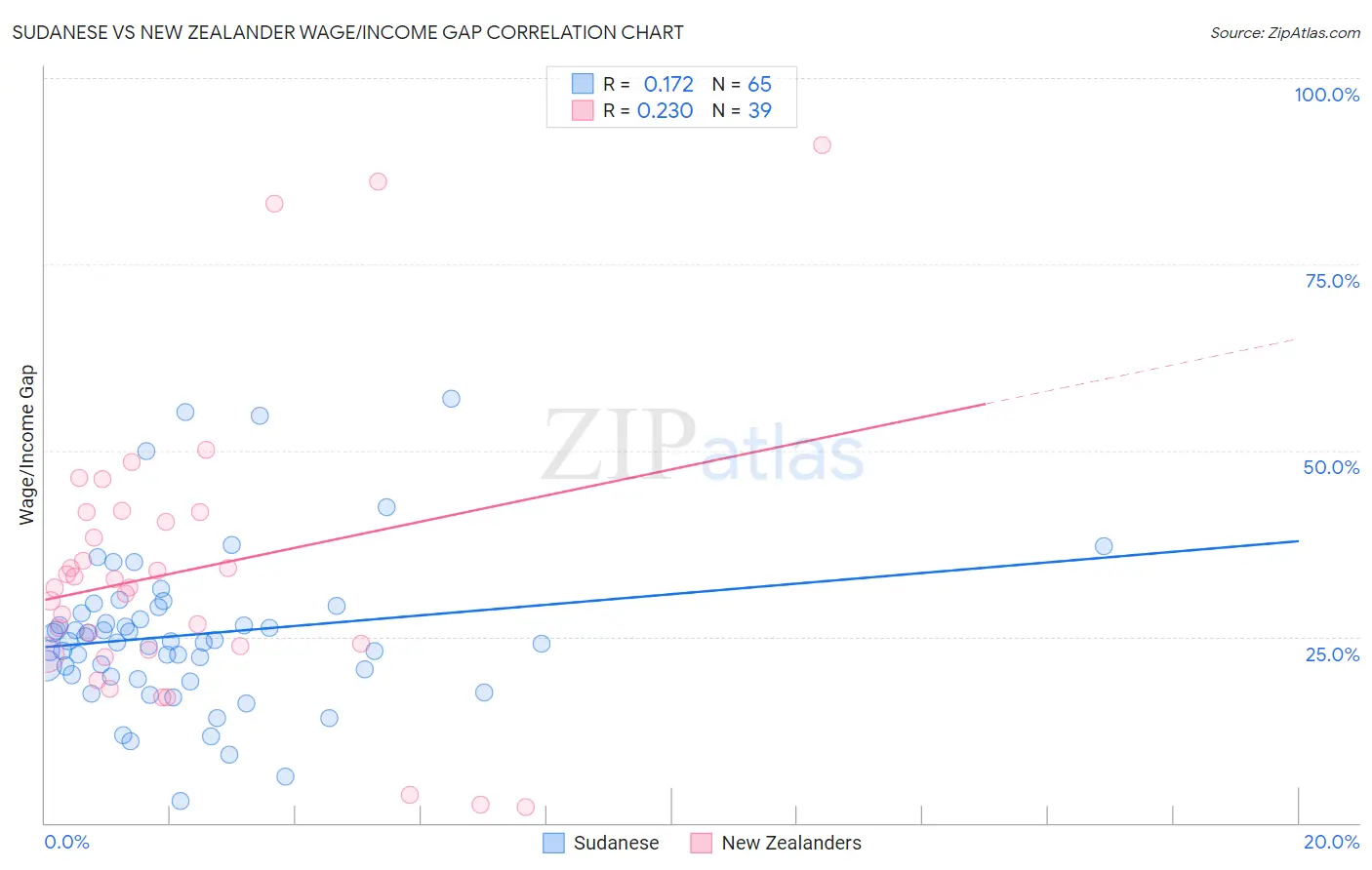Sudanese vs New Zealander Wage/Income Gap
COMPARE
Sudanese
New Zealander
Wage/Income Gap
Wage/Income Gap Comparison
Sudanese
New Zealanders
24.0%
WAGE/INCOME GAP
98.6/ 100
METRIC RATING
106th/ 347
METRIC RANK
27.7%
WAGE/INCOME GAP
1.0/ 100
METRIC RATING
268th/ 347
METRIC RANK
Sudanese vs New Zealander Wage/Income Gap Correlation Chart
The statistical analysis conducted on geographies consisting of 110,137,657 people shows a poor positive correlation between the proportion of Sudanese and wage/income gap percentage in the United States with a correlation coefficient (R) of 0.172 and weighted average of 24.0%. Similarly, the statistical analysis conducted on geographies consisting of 106,903,944 people shows a weak positive correlation between the proportion of New Zealanders and wage/income gap percentage in the United States with a correlation coefficient (R) of 0.230 and weighted average of 27.7%, a difference of 15.6%.

Wage/Income Gap Correlation Summary
| Measurement | Sudanese | New Zealander |
| Minimum | 2.9% | 2.1% |
| Maximum | 56.9% | 91.0% |
| Range | 54.1% | 88.9% |
| Mean | 25.2% | 33.8% |
| Median | 24.4% | 31.6% |
| Interquartile 25% (IQ1) | 19.8% | 23.2% |
| Interquartile 75% (IQ3) | 28.6% | 41.8% |
| Interquartile Range (IQR) | 8.8% | 18.5% |
| Standard Deviation (Sample) | 10.4% | 19.3% |
| Standard Deviation (Population) | 10.3% | 19.1% |
Similar Demographics by Wage/Income Gap
Demographics Similar to Sudanese by Wage/Income Gap
In terms of wage/income gap, the demographic groups most similar to Sudanese are Moroccan (24.0%, a difference of 0.0%), Tlingit-Haida (24.0%, a difference of 0.060%), Yaqui (24.0%, a difference of 0.30%), Immigrants from Albania (24.0%, a difference of 0.31%), and Ugandan (24.1%, a difference of 0.36%).
| Demographics | Rating | Rank | Wage/Income Gap |
| Aleuts | 99.2 /100 | #99 | Exceptional 23.7% |
| Yakama | 99.2 /100 | #100 | Exceptional 23.7% |
| Japanese | 99.1 /100 | #101 | Exceptional 23.8% |
| Immigrants | Laos | 99.0 /100 | #102 | Exceptional 23.8% |
| Tsimshian | 98.9 /100 | #103 | Exceptional 23.9% |
| Tlingit-Haida | 98.7 /100 | #104 | Exceptional 24.0% |
| Moroccans | 98.6 /100 | #105 | Exceptional 24.0% |
| Sudanese | 98.6 /100 | #106 | Exceptional 24.0% |
| Yaqui | 98.4 /100 | #107 | Exceptional 24.0% |
| Immigrants | Albania | 98.4 /100 | #108 | Exceptional 24.0% |
| Ugandans | 98.3 /100 | #109 | Exceptional 24.1% |
| Immigrants | Morocco | 98.1 /100 | #110 | Exceptional 24.1% |
| Soviet Union | 97.6 /100 | #111 | Exceptional 24.2% |
| Immigrants | Colombia | 97.0 /100 | #112 | Exceptional 24.3% |
| Sioux | 96.9 /100 | #113 | Exceptional 24.3% |
Demographics Similar to New Zealanders by Wage/Income Gap
In terms of wage/income gap, the demographic groups most similar to New Zealanders are Potawatomi (27.7%, a difference of 0.010%), Turkish (27.7%, a difference of 0.080%), Immigrants from Switzerland (27.7%, a difference of 0.10%), Serbian (27.7%, a difference of 0.10%), and Hmong (27.7%, a difference of 0.10%).
| Demographics | Rating | Rank | Wage/Income Gap |
| Immigrants | Germany | 1.5 /100 | #261 | Tragic 27.5% |
| Immigrants | Lebanon | 1.5 /100 | #262 | Tragic 27.5% |
| Syrians | 1.4 /100 | #263 | Tragic 27.6% |
| Immigrants | Switzerland | 1.0 /100 | #264 | Tragic 27.7% |
| Serbians | 1.0 /100 | #265 | Tragic 27.7% |
| Hmong | 1.0 /100 | #266 | Tragic 27.7% |
| Turks | 1.0 /100 | #267 | Tragic 27.7% |
| New Zealanders | 1.0 /100 | #268 | Tragic 27.7% |
| Potawatomi | 0.9 /100 | #269 | Tragic 27.7% |
| Immigrants | Western Europe | 0.9 /100 | #270 | Tragic 27.8% |
| Ute | 0.8 /100 | #271 | Tragic 27.8% |
| Immigrants | Korea | 0.8 /100 | #272 | Tragic 27.8% |
| Bulgarians | 0.7 /100 | #273 | Tragic 27.8% |
| Americans | 0.7 /100 | #274 | Tragic 27.8% |
| Immigrants | Japan | 0.7 /100 | #275 | Tragic 27.9% |